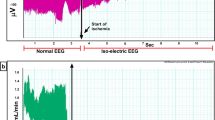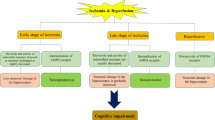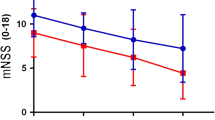Abstract
Several mechanisms are involved in the loss of cellular integrity and tissue destructions in various brain regions during ischemic insult. The affected brain employs various self-repair mechanisms during the poststroke recovery. Therefore, the current study involves time course changes in different brain regions following ischemia in terms of inflammation, oxidative stress and apoptosis for which a bilateral common carotid arteries occlusion model was chosen. The development of oxidative stress was seen with a marked increase in ROS and NO levels with concomitant decrease in GSH levels and also the activities of anti-oxidant enzymes. These alterations were accompanied with decreased levels of neurotransmitters and motor and cognitive deficits at various time points. Increased expressions of various pro-inflammatory cytokines and a decline in BDNF levels in hippocampal regions on 7th day post ischemia, suggesting their role in its pathogenesis. The restoration of BDNF and neurotransmitter levels along with significant decline in inflammatory cytokine levels 14th day onwards following ischemia in hippocampus suggested poststroke recovery. The extent of neuronal damage was found to be increased significantly on 7th day post ischemia as indicated by TUNEL assay and hematoxylin and eosin staining depicting enhanced number of pyknotic neurons in cortical and hippocampal regions. Cortical regions of the ischemic brains were severely affected while hippocampal regions showed significant poststroke recovery, which might attributed to the normalization of BDNF and pro-inflammatory cytokine levels. In conclusion, the present study established the central role of BDNF and pro-inflammatory cytokines in the poststroke recovery. Also, the cortical and hippocampal regions were found to be more susceptible for ischemic injury. As our results indicated, full recovery after ischemic injury in different brain regions was not achieved, therefore further studies with long-term recovery time are required to be conducted.
Graphic abstract









Similar content being viewed by others
Abbreviations
- TGCI:
-
Transient global cerebral ischemia
- ROS/RNS:
-
Reactive oxygen species/reactive nitrogen species
- DA:
-
Dopamine
- NE:
-
Norepinephrine
- 5-HT:
-
Sertonin
- DTNB:
-
5,5′-Dithiobis-(2-nitrobenzoic acid)
- TTC:
-
Triphenyltetrazolium chloride
- ECD:
-
Electrochemical detector
- TL:
-
Transfer latency
- BDNF:
-
Brain derived neurotrophic factor
- LSD:
-
Least significant difference
References
Simats A, García-Berrocoso T, Montaner J (2016) Neuroinflammatory biomarkers: from stroke diagnosis and prognosis to therapy. Biochim Biophys Acta 1862:411–424. https://doi.org/10.1016/j.bbadis.2015.10.025
Woodruff TM, Thundyil J, Tang S-C et al (2011) Pathophysiology, treatment, and animal and cellular models of human ischemic stroke. Mol Neurodegener 6:11. https://doi.org/10.1186/1750-1326-6-11
Lee J-M, Grabb MC, Zipfel GJ, Choi DW (2000) Brain tissue responses to ischemia. J Clin Invest 106:723–731. https://doi.org/10.1172/JCI11003
Lee J-C, Won M-H (2014) Neuroprotection of antioxidant enzymes against transient global cerebral ischemia in gerbils. Anat Cell Biol 47:149–156. https://doi.org/10.5115/acb.2014.47.3.149
Kalogeris T, Baines CP, Krenz M, Korthuis RJ (2012) Cell biology of ischemia/reperfusion injury. Int Rev Cell Mol Biol 298:229–317. https://doi.org/10.1016/B978-0-12-394309-5.00006-7
Kalogeris T, Bao Y, Korthuis RJ (2014) Mitochondrial reactive oxygen species: a double edged sword in ischemia/reperfusion vs preconditioning. Redox Biol 2:702–714. https://doi.org/10.1016/j.redox.2014.05.006
Esenwa CC, Elkind MS (2016) Inflammatory risk factors, biomarkers and associated therapy in ischaemic stroke. Nat Rev Neurol 12:594–604. https://doi.org/10.1038/nrneurol.2016.125
Kelly PJ, Murphy S, Coveney S et al (2018) Anti-inflammatory approaches to ischaemic stroke prevention. J Neurol Neurosurg Psychiatry 89:211–218. https://doi.org/10.1136/jnnp-2016-314817
Amantea D, Bagetta G (2017) Excitatory and inhibitory amino acid neurotransmitters in stroke: from neurotoxicity to ischemic tolerance. Curr Opin Pharmacol 35:111–119. https://doi.org/10.1016/j.coph.2017.07.014
Gu W, Gu C, Jiang W, Wester P (2010) Neurotransmitter synthesis in poststroke cortical neurogenesis in adult rats. Stem Cell Res 4:148–154. https://doi.org/10.1016/j.scr.2009.12.001
Berg C, Backström T, Winberg S et al (2013) Developmental exposure to fluoxetine modulates the serotonin system in hypothalamus. PLoS ONE 8:e55053. https://doi.org/10.1371/journal.pone.0055053
Alcantara CC, García-Salazar LF, Silva-Couto MA et al (2018) Post-stroke BDNF concentration changes following physical exercise: a systematic review. Front Neurol 9:637. https://doi.org/10.3389/fneur.2018.00637
Ji X-W, Wu C-L, Wang X-C et al (2014) Monoamine neurotransmitters and fibroblast growth factor-2 in the brains of rats with post-stroke depression. Exp Ther Med 8:159–164. https://doi.org/10.3892/etm.2014.1674
Mergenthaler P, Dirnagl U, Meisel A (2004) Pathophysiology of stroke: lessons from animal models. Metab Brain Dis 19:151–167
Bartsch T, Döhring J, Reuter S et al (2015) Selective neuronal vulnerability of human hippocampal CA1 neurons: lesion evolution, temporal course, and pattern of hippocampal damage in diffusion-weighted MR imaging. J Cereb Blood Flow Metab 35:1836–1845. https://doi.org/10.1038/jcbfm.2015.137
Wang X, Michaelis EK (2010) Selective neuronal vulnerability to oxidative stress in the brain. Front Aging Neurosci 2:12. https://doi.org/10.3389/fnagi.2010.00012
Cavaglia M, Dombrowski SM, Drazba J et al (2001) Regional variation in brain capillary density and vascular response to ischemia. Brain Res 910:81–93
Wang X, Pal R, Chen X-W et al (2005) High intrinsic oxidative stress may underlie selective vulnerability of the hippocampal CA1 region. Brain Res Mol Brain Res. https://doi.org/10.1016/j.molbrainres.2005.07.018
Sieber FE, Palmon SC, Traystman RJ, Martin LJ (1995) Global incomplete cerebral ischemia produces predominantly cortical neuronal injury. Stroke 26:2091–2095 (discussion 2096)
Hara A, Yoshimi N, Hirose Y et al (1995) DNA fragmentation in granular cells of human cerebellum following global ischemia. Brain Res 697:247–250. https://doi.org/10.1016/0006-8993(95)00902-3
Wang K, Damjanov I, Wan Y-JY (2010) The protective role of pregnane X receptor in lipopolysaccharide/D-galactosamine-induced acute liver injury. Lab Investig 90:257–265. https://doi.org/10.1038/labinvest.2009.129
Ouyang Y-B, Voloboueva LA, Xu L-J, Giffard RG (2007) Selective dysfunction of hippocampal CA1 astrocytes contributes to delayed neuronal damage after transient forebrain ischemia. J Neurosci 27:4253–4260. https://doi.org/10.1523/JNEUROSCI.0211-07.2007
Kirino T, Sano K (1984) Selective vulnerability in the gerbil hippocampus following transient ischemia. Acta Neuropathol 62:201–208. https://doi.org/10.1007/BF00691853
Jingtao J, Sato S, Yamanaka N (1999) Changes in cerebral blood flow and blood brain barrier in the gerbil hippocampal CA1 region following repeated brief cerebral ischemia. Med Electron Microsc 32:175–183. https://doi.org/10.1007/s007959900012
Himori N, Watanabe H, Akaike N et al (1990) Cerebral ischemia model with conscious mice. Involvement of NMDA receptor activation and derangement of learning and memory ability. J Pharmacol Methods 23:311–327
Morris RG, Garrud P, Rawlins JN, O’Keefe J (1982) Place navigation impaired in rats with hippocampal lesions. Nature 297:681–683
Itoh J, Nabeshima T, Kameyama T (1991) Utility of an elevated plus-maze for dissociation of amnesic and behavioral effects of drugs in mice. Eur J Pharmacol 194:71–76
Gaur V, Aggarwal A, Kumar A (2009) Protective effect of naringin against ischemic reperfusion cerebral injury: possible neurobehavioral, biochemical and cellular alterations in rat brain. Eur J Pharmacol 616:147–154. https://doi.org/10.1016/j.ejphar.2009.06.056
Bishnoi M, Chopra K, Kulkarni SK (2006) Involvement of adenosinergic receptor system in an animal model of tardive dyskinesia and associated behavioural, biochemical and neurochemical changes. Eur J Pharmacol 552:55–66. https://doi.org/10.1016/j.ejphar.2006.09.010
Church WH (2005) Column chromatography analysis of brain tissue: an advanced laboratory exercise for neuroscience majors. J Undergrad Neurosci Educ 3:A36–A41
Lowry OH, Rosebrough NJ, Farr AL, Randall RJ (1951) Protein measurement with the Folin phenol reagent. J Biol Chem 193:265–275
Best TM, Fiebig R, Corr DT et al (1999) Free radical activity, antioxidant enzyme, and glutathione changes with muscle stretch injury in rabbits. J Appl Physiol 87:74–82
Raddassi K, Berthon B, Petit J-F, Lemaire G (1994) Role of calcium in the activation of mouse peritoneal macrophages: induction of NO synthase by calcium ionophores and thapsigargin. Cell Immunol 153:443–455. https://doi.org/10.1006/cimm.1994.1041
Ellman GL (1959) Tissue sulfhydryl groups. Arch Biochem Biophys 82:70–77
Kono Y (1978) Generation of superoxide radical during autoxidation of hydroxylamine and an assay for superoxide dismutase. Arch Biochem Biophys 186:189–195
Luck H (1963) Catalase. In: Bergmeyer HW (ed) Methods of enzymatic analysis, section 3. Academic Press, New York, pp 885–894
Pearse AG (1960) This week’s citation classic. R Postgrad Mcd Sch 998
Hoesch RE, Koenig MA, Geocadin RG (2008) Coma after global ischemic brain injury: pathophysiology and emerging therapies. Crit Care Clin 24:25–44. https://doi.org/10.1016/j.ccc.2007.11.003
Zhang X, Deguchi K, Yamashita T et al (2010) Temporal and spatial differences of multiple protein expression in the ischemic penumbra after transient MCAO in rats. Brain Res 1343:143–152. https://doi.org/10.1016/j.brainres.2010.04.027
Li F, Irie K, Anwer MS, Fisher M (1997) Delayed triphenyltetrazolium chloride staining remains useful for evaluating cerebral infarct volume in a rat stroke model. J Cereb Blood Flow Metab 17:1132–1135. https://doi.org/10.1097/00004647-199710000-00016
Adibhatla RM, Hatcher JF (2010) Lipid oxidation and peroxidation in CNS health and disease: from molecular mechanisms to therapeutic opportunities. Antioxid Redox Signal 12:125–169. https://doi.org/10.1089/ars.2009.2668
Raghavendra Rao VL, Rao AM, Dogan A et al (2000) Glial glutamate transporter GLT-1 down-regulation precedes delayed neuronal death in gerbil hippocampus following transient global cerebral ischemia. Neurochem Int 36:531–537
Bragin DE, Zhou B, Ramamoorthy P et al (2010) Differential changes of glutathione levels in astrocytes and neurons in ischemic brains by two-photon imaging. J Cereb Blood Flow Metab 30:734–738. https://doi.org/10.1038/jcbfm.2010.9
Candelario-Jalil E, Mhadu NH, Al-Dalain SM et al (2001) Time course of oxidative damage in different brain regions following transient cerebral ischemia in gerbils. Neurosci Res 41:233–241
Manto M, Bower JM, Conforto AB et al (2012) Consensus paper: roles of the cerebellum in motor control—the diversity of ideas on cerebellar involvement in movement. The Cerebellum 11:457–487. https://doi.org/10.1007/s12311-011-0331-9
Hara A, Yoshimi N, Hirose Y et al (1995) DNA fragmentation in granular cells of human cerebellum following global ischemia. Brain Res 697:247–250
Bello EP, Casas-Cordero R, Galiñanes GL et al (2016) Inducible ablation of dopamine D2 receptors in adult mice impairs locomotion, motor skill learning and leads to severe parkinsonism. Mol Psychiatry. https://doi.org/10.1038/mp.2016.105
Martín A, Szczupak B, Gómez-Vallejo V et al (2013) PET imaging of serotoninergic neurotransmission with [11C]DASB and [18F]altanserin after focal cerebral ischemia in rats. J Cereb Blood Flow Metab 33:1967–1975. https://doi.org/10.1038/jcbfm.2013.156
Cao W, Drumheller A, Zaharia M et al (1993) Effects of experimentally induced ischemia on dopamine metabolism in rabbit retina. Invest Ophthalmol Vis Sci 34:3140–3146
Oliva I, Fernández M, Martín ED (2013) Dopamine release regulation by astrocytes during cerebral ischemia. Neurobiol Dis 58:231–241. https://doi.org/10.1016/j.nbd.2013.06.007
Shimizu-Sasamata M, Yamamoto M, Okada M et al (1991) Effects of indeloxazine hydrochloride on behavioral and biochemical changes in the chronic phase of focal cerebral ischemia in rats. Arch Int Pharmacodyn Ther 314:74–89
Ferrari RS, Andrade CF, Ferrari RS, Andrade CF (2015) Oxidative stress and lung ischemia-reperfusion injury. Oxid Med Cell Longev 2015:1–14. https://doi.org/10.1155/2015/590987
Stamenkovic S, Sekeljic V, Radenovic LAP (2012) Ischemia and neurogenesis: link between neurodegeneration and repair. In: ICG, AW (eds) Neurogenesis research: new developments. NOVA Science Publishers, Inc. New York, pp 115–136
Lichtenwalner RJ, Parent JM (2006) Adult neurogenesis and the ischemic forebrain. J Cereb Blood Flow Metab 26:1–20. https://doi.org/10.1038/sj.jcbfm.9600170
Vandenbosch R, Borgs L, Beukelaers P et al (2009) Adult neurogenesis and the diseased brain. Curr Med Chem 16:652–666
Ziemka-Nałęcz M, Zalewska T (2012) Endogenous neurogenesis induced by ischemic brain injury or neurodegenerative diseases in adults. Acta Neurobiol Exp (Wars) 72:309–324
Chen A, Xiong L-J, Tong Y, Mao M (2013) The neuroprotective roles of BDNF in hypoxic ischemic brain injury. Biomed Rep 1:167–176. https://doi.org/10.3892/br.2012.48
Ploughman M, Windle V, MacLellan CL et al (2009) Brain-derived neurotrophic factor contributes to recovery of skilled reaching after focal ischemia in rats. Stroke 40:1490–1495. https://doi.org/10.1161/STROKEAHA.108.531806
Xie Z-M, Wang X-M, Xu N et al (2017) Alterations in the inflammatory cytokines and brain-derived neurotrophic factor contribute to depression-like phenotype after spared nerve injury: improvement by ketamine. Sci Rep 7:3124. https://doi.org/10.1038/s41598-017-03590-3
Acknowledgements
The study was carried out with the funds provided by Department of Science & Technology/Innovation in Science Pursuit for Inspired Research (DST/INSPIRE), India with IF no. IF130058.
Author information
Authors and Affiliations
Corresponding author
Ethics declarations
Conflict of interest
The authors do not have any conflict of interest in the manuscript.
Ethical approval
The authors have read and abided by the statement of the ethical standards for manuscripts submitted to this journal.
Additional information
Publisher's Note
Springer Nature remains neutral with regard to jurisdictional claims in published maps and institutional affiliations.
Rights and permissions
About this article
Cite this article
Kapoor, M., Sharma, S., Sandhir, R. et al. Temporal changes in physiological and molecular markers in various brain regions following transient global ischemia in rats. Mol Biol Rep 46, 6215–6230 (2019). https://doi.org/10.1007/s11033-019-05060-7
Received:
Accepted:
Published:
Issue Date:
DOI: https://doi.org/10.1007/s11033-019-05060-7




